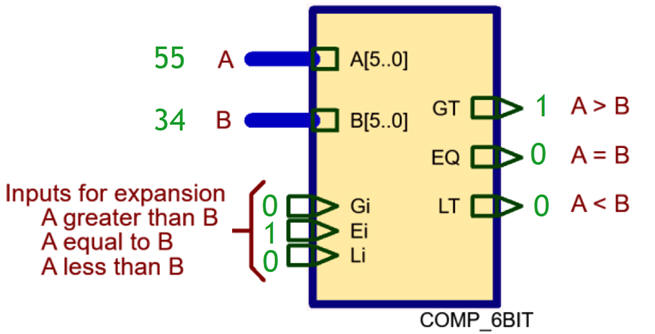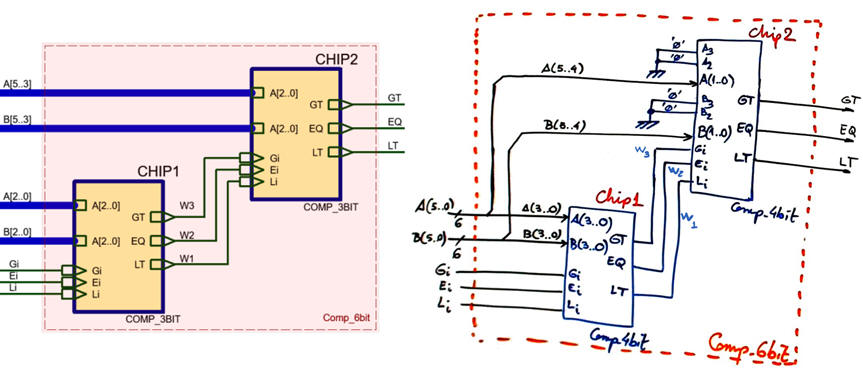L3.2: Plan C2 and circuit expandability (circuit scalability) [P3] n-bit arithmetic circuits |
[6 Oct] |
1.9.1.2. n-bit adder
1.9.1.2.1. Ripple-carry adder: Adder_4bit, Adder_8bit
This tutorial shows how to design an Adder_4bit using Adder_1bit blocks. The key idea in this lecture is discussing the plan C2 internal architecture and study its direct translation to Adder_4bit.vhd (coloured pdf printing; here is explained how to do it):
|
|
 |
1.9.1.3. Commercial standard adder chips in classic technologies
This is a commercial standard 4-bit adder Adder_4bit 74HCT283. It is based on carry lookahead (CLA) equations plan A architecture as shown in tutorial Adder_4bit.
1.9.2.2. n-bit comparator (Comp_4bit, Comp_8bit, etc.)
The idea on how to organise a larger comparator, for instance Comp_6bit, is based on using auxiliary inputs Gi, Ei, Li to allow cascading circuits of the same kind.

Comp_6bit can be invented using these two approaches shown below where Comp_4bit or Comp_3bit can be implemented using Comp_1bit:

In this way, other comparator tutorial projects can be found: Comp_4bit, Comp_10bit chaining Comp_1bit components.
1.9.2.3. Commercial standard comparator chips in classic technologies
Commercial standard 4-bit comparator Comp_4bit 74F85. It is based on plan A equations as shown in this tutorial Comp_4bit.
1.9.3.2. n-bit multipliers
Mult_8bit. and Mult_9bit.
1.9.4. Counting the number of ones in a n-input vector: Ones_counter_nbit
1.9.4.1. Ones_counter_4bit
Counting the number of ones in a given data vector: Ones_counter_4bit. This is the typical application for counting the number of free slots in a parking.
1.9.4.2. Ones_counter_8bit.
This project is highlighted in P3: Ones_counter_8bit.
Indeed, most standard circuits may be inferred in the same way using modular hierarchical structures and repeatable building blocks (plan C2). This is the idea of circuit expandability or scalability proposed as a concept at the mind map. Some examples for both, arithmetic and logic circuit types:
| Circuit using plan C2 | Building blocks |
| MUX_8 | Mux_2 and MUX_4 |
| Octuple_Mux_4 | Mux_2 |
| Dec_4_16 | Dec_2_4 |
| Enc_10_4 | Enc_4_2 |
| Adder_4bit, | Adder_1bit |
| Adder_8bit | Adder_1bit, Adder_4bit |
| Comp_6bit | Comp_4bit, Comp_1bit |
| Mult_4bit | Mult_1bit |
| Ones_counter_8bit | Ones_counter_4bit |
The same concept of circuit expandability will be used in Chapter 2 on the design of counters, memories, registers, etc.
Activity #1 on circuit expandability applying plan C2: Design a Dec_4_16 using smaller blocks of the same kind like Dec_2_4, wires, cables and logic gates if necessary.

Activity #2 on arithmetic operations: Perform the following operations in radix-2
S = (345)10 + (677)10
S = (879)10 - (234)10
S = (87)10 x (34)10
A = (817)10 compared to B = (332)10
Activity #3 on circuit expandability applying plan C2: Invent a MUX_16 using a hierarchical design based on MUX_4 components.


